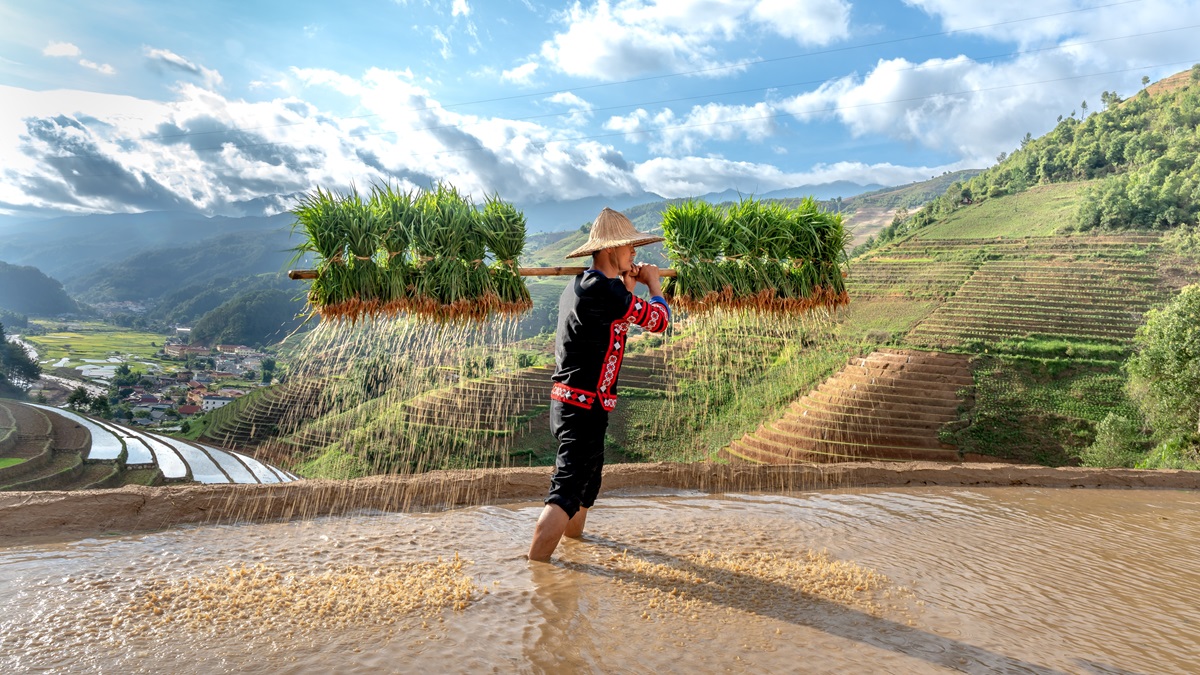Greater cooperation and policy coordination are key to reviving the landmark Global System of Trade Preferences among Developing Countries for a greener and better tomorrow.
© Shutterstock/Quang nguyen vinh | A farmer cultivates jasmine rice in Yen Bai Province of Vietnam, a participant of the Global System of Trade Preferences among Developing Countries.
The Global System of Trade Preferences (GSTP) among Developing Countries, established in 1989, is not only a historic agreement but also an effective instrument for addressing today’s challenges.
Created by the G77 bloc of developing countries, the GSTP aims to promote trade among nations in the Global South, primarily through preferential tariff reductions.
Its 42 members across Africa, Asia and Latin America represent a combined market of $16 trillion, generating some $4.4 trillion in import demand for goods – almost 20% of global merchandise imports.
UNCTAD provides substantive and technical support for the implementation of the agreement, overseen by a committee of participants, its highest decision-making organ.
Productive use of GSTP to meet global challenges
While the latest GSTP tariff reductions still require one more ratification before entering into force, its members can at the same time step up ambitions and key areas of South-South cooperation to advance sustainable trade and development.
As the committee met on 19 September for its 32nd session, UNCTAD Secretary-General Rebeca Grynspan called on countries to think creatively and take decisive actions to put GSTP into productive use to address pressing global challenges.
“Under the current context of ‘polycrisis’, the GSTP can provide a valuable platform for advancing trade cooperation to achieve sustainable energy transition, decarbonization and greater food security,” the secretary-general said.
“I wish to assure you of UNCTAD’s full commitment to supporting your effort to strengthen South-South trade cooperation under the GSTP.”
Advancing a just energy transition
The world’s collective vision for net-zero emissions by 2050 has given renewed impetus for low-carbon technologies (LCTs) to propel a just global energy transition.
They include technologies to produce renewable energy from solar, wind, hydro and sustainable biofuel power generation systems, as well as energy storage and transformation sub-systems that deliver electricity for end use.
In this regard, several GSTP members are already emerging as competitive exporters, such as Malaysia, Mexico, Singapore and Thailand.
Moreover, the GSTP framework can help its members advance sustainable energy transition through enhancing cooperation in the production and trade of the LCT products.
The agreement, for example, can offer its members a large, aggregate market to build LCT value chains, thanks to supportive tariff and non-tariff measures.
Improving health supplies and services
Trade among GSTP members can facilitate manufacturing knowledge sharing, foster innovation, diversify import sources to improve resilience and build supply chains among them.
In this sense, the health sector can also benefit from deeper integration among the GSTP membership, concerning areas such as drugs, vaccines, medical devices and health services.
During the COVID-19 crisis, several GSTP members suffered reduced access to medical supplies – one major cause being the group’s high dependency on imports of essential products from a handful of suppliers.
Boosting intra-GSTP trade in the public health sector can help enhance access to essential supplies, while facilitating trade in medical services such as health tourism, the establishment of foreign-owned medical firms and temporary migration of medical staff.
Bolstering food security
Another sector with ample potential for cooperation and sustainable production is the food sector, most notably agriculture, fisheries and aquaculture.
Agricultural products tend to receive higher tariff protection than industrial products. As UNCTAD noted, average applied most-favoured-nation tariffs on agricultural products are at 14.5% for GSTP participants, compared to 8.4% for high-income countries.
But when it comes to their main agricultural exports, GSTP participants have a high degree of complementarity, as they occupy different climatic zones and have varied consumption cultures.
With that in mind, the GSTP framework seeks to ensure food security by improving access, availability and affordability, while supporting export and import diversification.
Promoting a circular economy
GSTP can also help accelerate the transition to a sustainable circular economy that not only protects the environment by leveraging natural resources but also creates jobs and develops new sectors and capabilities.
GSTP members have an advantage in producing natural materials. These can be seaweed, bamboo and jute in Asia, coconut husks and bagasse in many Caribbean and Pacific Island nations or sisal and corn husks in Latin America.
Trading these materials and related products can help gradually reduce plastic pollution among GSTP participants, while improving opportunities for sustainability, integration and circularity of the agriculture, aquaculture and silviculture value chains.

